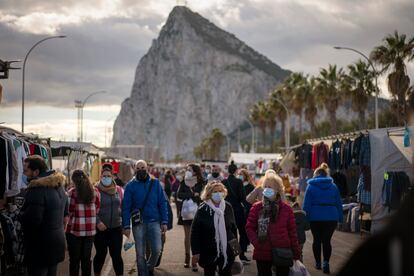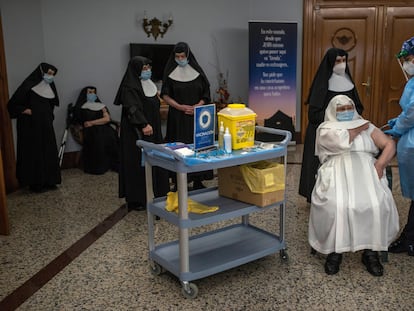New strain of coronavirus has been circulating in Spain for two weeks, experts conclude
The mutation of SARS-CoV-2 first identified in the United Kingdom has been detected by a research foundation in Valencia in two patients with no epidemiological connection to the country

The new, more contagious strain of the coronavirus that was first detected in the United Kingdom is already circulating in Spain between people who have no epidemiological connection with that country. That’s according to a preliminary genetic analysis carried out by the Fisabio Foundation research institute in Valencia, which has found the same mutations of SARS-CoV-2 that were detected in the UK in samples taken two weeks ago from two patients who had not traveled to the country, nor come into contact with someone who had.
The official confirmation of this discovery is pending the completion of the genome sequencing of the virus by researchers, something that is likely to be done by next week. At the same time, hospitals in regions such as Madrid and Andalusia are waiting for the results of genetic sequencing so that they can also confirm cases of this new strain that have no link to UK travel. The results in these cases will also not be ready until late next week.
“There has been community transmission of the new variant for around two weeks now, but at levels that should be very low,” explains Fernando González Candelas, a genetics professor at the University of Valencia and a researcher at the Fisabio Foundation. “We have done a partial sequencing and have seen that the sample presents the same mutations as those detected in the United Kingdom,” he continues. “I have no doubt of it because it is not just one mutation, but rather many, although for now we need to complete the genome sequencing.”
There has been community transmission of the new variant for around two weeks now, but at levels that should be very lowFernando González Candelas, researcher at Fisabio Foundation
The new variant of the coronavirus has more than 15 mutations, according to information from the UK. Of these, the most important ones affect the spike protein used by SARS-CoV-2 to infect cells. Sources in the UK say that this strain is as much as 70% more transmissible than the one that has been circulating since March, although this information will have to be confirmed by new research.
The government of British Prime Minister Boris Johnson has attributed the highly infectious nature of this new strain to the exponential rise in cases in the country, which led this week to a new national lockdown.
Pere Godoy, the president of the Spanish Epidemiological Society, believes that “it is not possible to predict the behavior of the new variant in other countries. This is a process that depends on a lot of factors, such as possible new changes in the virus itself, the rollout of vaccines, the number of people who have already had the infection, local dynamics… We have to monitor everything that happens from now on,” he adds.
The Health Ministry and the regions – which are in charge of their own health systems in Spain – discussed the issue at a meeting on Tuesday about the progress of the pandemic. According to a spokesperson, the sequence of the virus is “being studied with the National Microbiology Center and other centers to see if this strain is present in Spain.” The ministry adds that “it cannot be confirmed that there is community transmission” of the variant until the genetic sequencing of the samples is completed.
It is not possible to predict the behavior of the new variant in other countries. This is a process that depends on a lot of factorsPere Godoy, president of the Spanish Epidemiological Society
The research by Fisabio is the most advanced, but a chance discovery by British researchers is allowing hospitals to progress in detecting the strain thanks to the PCR tests from the company Thermo Fisher. These kits use three regions of the virus to detect its presence in samples. But one of these regions is where the new strain has mutated the most, meaning it is not detected by the PCR test. “This means that if the test comes back positive in this part, you can definitely rule out that the virus is the new strain,” explains Juan Carlos Galán, head virologist at Madrid’s Ramón y Cajal Hospital. “If the test, which is called Multiplex, is positive in the other two regions and negative in this one, it’s a significant indication that you’re dealing with the new strain,” he adds.
Using this strategy at Ramón y Cajal, “from 700 positive cases, seven – 1% – have given us the profile of the new strain. But we have gone further and we have applied another technique from the same company called Singleplex, and the results have gone the same way. With the two tests, and ahead of the genetic sampling confirming the results, this opens the path to identify the new strain nearly in real time without having to wait for the genetic sequencing,” Galán continues.
Andalusia is another Spanish region where the new strain has already been detected, in part due to the presence of Gibraltar, the British Overseas Territory located off the southern coast of Spain. Two heads of service at major public hospitals have also confirmed that there have been “several cases with no epidemiological link to The Rock,” as Gibraltar is commonly known, “or to the United Kingdom.” With the Thermo Fisher PCR tests, this “points to community transmission of the new strain.”
One of these hospital officials, speaking on condition of anonymity, said that their impression was that “it has been circulating now for some weeks. What we cannot know is the extent to which it is contributing to the rise in incidence, because it has also coincided with the cold, more time spent inside homes, the holiday season…”
All experts consulted believe that the arrival of the strain in Spain was inevitable given the steady stream of people moving between Spain and the United Kingdom, as well as the weeks that passed since the new variant began to circulate in the latter country to the time that restrictions were put on passengers arriving in Spain from that territory – currently limited to Spanish citizens and non-nationals with residency status.
“The variant could have circulated in Spain and other countries without being detected, but at very low levels,” explains González Candelas. This researcher believes, however, that it is still early to know whether it will spread throughout Spain. “We have to take into account that most importations, with this or other viruses, are unsuccessful and do not open relevant new chains of infections. And it is also not clear, although there are relevant signs that need to be studied, how much more infectious it is, because the data does not yet have the analytical rigor necessary nor the repeatability needed,” he concludes.
English version by Simon Hunter.
Tu suscripción se está usando en otro dispositivo
¿Quieres añadir otro usuario a tu suscripción?
Si continúas leyendo en este dispositivo, no se podrá leer en el otro.
FlechaTu suscripción se está usando en otro dispositivo y solo puedes acceder a EL PAÍS desde un dispositivo a la vez.
Si quieres compartir tu cuenta, cambia tu suscripción a la modalidad Premium, así podrás añadir otro usuario. Cada uno accederá con su propia cuenta de email, lo que os permitirá personalizar vuestra experiencia en EL PAÍS.
¿Tienes una suscripción de empresa? Accede aquí para contratar más cuentas.
En el caso de no saber quién está usando tu cuenta, te recomendamos cambiar tu contraseña aquí.
Si decides continuar compartiendo tu cuenta, este mensaje se mostrará en tu dispositivo y en el de la otra persona que está usando tu cuenta de forma indefinida, afectando a tu experiencia de lectura. Puedes consultar aquí los términos y condiciones de la suscripción digital.
More information
Últimas noticias
Raúl Rocha, from jet-setting with Miss Universe to arms trafficking and fuel theft
80,000 barrels of Mexican oil sent to Cuba: Havana drawn into the US–Mexico clash
Human rights activists, opposition members, and a minor: Maduro’s other political prisoners
Israel sparks a civil war within the MAGA movement
Most viewed
- Reinhard Genzel, Nobel laureate in physics: ‘One-minute videos will never give you the truth’
- Pablo Escobar’s hippos: A serious environmental problem, 40 years on
- Charles Dubouloz, mountaineering star, retires at 36 with a farewell tour inspired by Walter Bonatti
- Why we lost the habit of sleeping in two segments and how that changed our sense of time
- The fall of a prolific science journal exposes the billion-dollar profits of scientific publishing










































